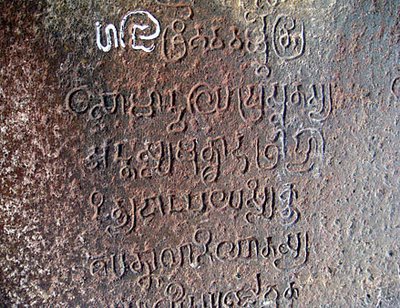Secrets uncovered
Stone sculptures yield clues to Cambodia's ancient Khmer culture - by Virginia Myers Kelly
With cracks in his smooth stone belly and his plump arms severed at the elbows, the statue of the god Shiva from Cambodia’s Angkor Wat region is not the imposing figure he once was. Shiva’s regal head, crowned in a conical diadem, still towers above the faithful who arrive to place offerings of flowers where his feet - long lost in the countryside of Cambodia - should be. At the National Museum of Cambodia in Phnom Penh, art conservators are slowly resurrecting Siva - the Hindu god of restoration and destruction - and other stone sculptures dating from the sixth to 13th centuries. There is Vishnu, preserver and sustainer of life, his legs and torso intact but arms and head missing; Buddha, still highly revered despite this particular statue’s head-only state; and King Jayavarman VII, his benign visage perched atop an armless torso. Jayavarman VII, one of the most notable rulers of Angkor, reigned when that kingdom’s elaborate temples were the center of a complex civilization. “Angkor was the most extensive preindustrial city in the world,” explains Conservation Scientist Janet Douglas, who is working hard to discover more about Jayavarman’s past. “It was a huge civilization that we’re just beginning to understand.”
Douglas, of the Smithsonian’s Freer Gallery of Art and Arthur M. Sackler Gallery, is conducting petrographic detective work on 29 samples of stone obtained from Khmer sculptures, such as the one of Jayavarman. Bertrand Porte, the École Française d’Extrême-Orient conservator who sent Douglas the samples, is pain-stakingly piecing the statues together. Before Douglas began her investigation, art historians weren’t sure exactly what types of stone the ancient carvers used and where it was quarried. In her laboratory, she has begun to unlock these secrets. This general lack of knowledge of Ankor’s statues has been aggravated by a number of factors. Tangled in jungle temples long buried by time, the statues were made inaccessible by years of war and political instability in Cambodia, land mines, unpaved or nonexistent roads, and a population that only recently has begun to appreciate the significance of its national treasures.
Douglas’ work is limited by a dearth of samples of reliable provenance. “By removing minute stone fragments from select spots on the statues, Porte has provided a rare opportunity to analyze the stone used by the Khmer,” with minimal harm to the artworks, Douglas says. Normally, “taking samples from sculpture is to be avoided, because we do not want to cause further damage to these historically important works of art.” In a lab at the Freer and Sackler galleries, the precious Khmer stone samples are stored near other artifacts under Douglas’ purview—among them fifth-century Korean gold earrings, an ancient jade ax and a dagger crusted with decayed cloth. The stone fragments look dull beside these treasures until she looks at them using a petrographic microscope. The Khmer sculpture samples are all composed of various types of sandstone. Sliced into translucent slivers and attached to microscope slides, the tiny brown stone samples, when magnified, become dazzling mosaics of jagged shapes fitted together like an ancient puzzle.
Douglas is using petrographic microscopy to categorize the sandstone fragments based on their grain types, using color, shape, texture and other rock characteristics, such as porosity and cementing materials. Douglas conducts higher magnification studies on a scanning electron microscope, where chemical compositional information can be collected on the grains within the sandstone. Cathodoluminescence microscopy is another tool being applied with the help of Sorena Sorensen, a geochemist in the Department of Mineral Sciences at the Smithsonian’s National Museum of Natural History. This method uses electrons to bombard a sandstone sample until it emits light to produce an image resembling brilliantly colored abstract art. These images are then analyzed to characterize the color, size and texture of the mineral grains. Using these analytical tools, Douglas can see past the gray sandstone and begin to consider its unique characteristics that are hidden on a microscopic level. Distinctions among the sandstones are based on relative amounts of various rock grains, such as quartz, feldspar, igneous, limestone and basalt, as well as natural cementing materials, weathering and geologic origins of certain grains.
In her examinations, Douglas has discovered that five of the samples are composed of grains weathered from igneous rock sources. This leads her to conclude that an important group of sculptures carved in the Bayon style and dated to the 12th to 13th century most likely originated from a common source, such as Cambodia’s Kulen Mountains. At the National Museum of Cambodia, Porte continues to restore the sculptures as they become available. Although Porte's efforts are dwarfed by the vast challenges of his location, Douglas is reinforcing his work in her laboratory on the National Mall. She expects that her research will someday help art historians lift the veil of mystery surrounding Angkor’s long-obscured past and its remarkable Khmer artisans.



0 Comments:
Post a Comment
<< Home